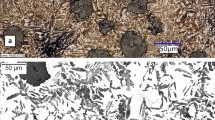Abstract
The influence of grain refinement on the mechanical properties of ferritic ductile iron was investigated. Alloys containing nominally 2%, 3%, and 4% silicon were produced for this study. Various heat treatments were employed to produce a fine-grained ferritic structure. Hardness, tensile, and Charpy impact properties were determined. The three alloys were austempered at 385 °C (725 °F). The austempered materials were then annealed between 540 and 732 °C (1000–1350 °F) to produce a fine-grained, 100% ferrite matrix. Intercritical heat treatments were also performed to produce a fine-grained acicular microstructure. Samples were both air-cooled and oil-quenched from the intercritical temperature and subsequently annealed to ferritize the material and enhance toughness. All three alloys were also tested in the fully annealed ferritic condition. All approaches to refine ferrite grain size were successful; the heat-treated alloys developed strengths comparable to the fully annealed SSSF 4%Si alloy. Based on Charpy impact testing, the grain-refined alloys displayed nil ductility temperatures below room temperature, whereas that of the 4% Si alloy was above room temperature.













Similar content being viewed by others
References
DIN European Standard EN 1563:2012-03, Founding – spheroidal graphite cast irons (2012)
A.S. Tettleman, A.J. McEvily Jr., Fracture of Structural Materials (Wiley, New York, 1967)
L.E. Bjorkegren, K. Hamberg, Silicon alloyed ductile iron with excellent ductility and machinability, in Keith Millis Symposium, pp. 70–90 (2003)
W.J.M. Tegart, Elements of mechanical metallurgy (Macmillan Publishing Co., Inc., New York, 1966), p. 175
R.B. Gundlach, Observations on structure control to improve the properties of cast irons. Honorary Lecture – Cast Iron Division, AFS Casting Congress (2008)
International Standard ISO 1083;2004, Spheroidal graphite cast irons – classification (2004)
J.M. Tartaglia, R.B. Gundlach, G.M. Goodrich, Optimizing structure-property relationships in ductile iron. Int. J. Metalcast. 8, 7–38 (2014). https://doi.org/10.1007/BF03355592
R.B. Gundlach, Normalizing heat treatments to develop improved properties in heavy section ductile iron, DIS Research Report 48 (2014)
F. Zanardi, The development of ADI and IDI in Italy. in AFS/DIS 2008 Keith Millis Symposium on Ductile Cast Iron (2008)
K.L. Hayrynen, J.R. Keough, B.V. Kovacs, The effects of alloying elements on the critical temperatures in ductile iron, Ductile Iron Society, Research Report No. 22 (1997)
J. Barsom, S. Rolfe (eds.), Fracture and Fatigue Control in Structures: Applications of Fracture Mechanics, 3rd edn. (ASTM International, West Conshohocken, 1999). https://doi.org/10.1520/MNL41-3RD-EB
Acknowledgements
This investigation was funded jointly by the Ductile Iron Society and American Foundry Society under DIS Research Project No. 57 and AFS Project 17-18#02. Melting and preliminary heat treatment studies were performed at Michigan Technological University, an FEF university, under the direction of Professor Paul Sanders. Special thanks go to Ms. Julia Scruton, who performed the preliminary heat treatment experiments, which became the basis for all subsequent heat treatments employed in this study. Austempering was performed by Applied Process, Inc. Final heat treatments and all mechanical testing were performed by Element Materials Technology, Wixom, MI.
Author information
Authors and Affiliations
Corresponding author
Additional information
Publisher's Note
Springer Nature remains neutral with regard to jurisdictional claims in published maps and institutional affiliations.
Rights and permissions
About this article
Cite this article
Gundlach, R.B. Heat Treatments to Develop High-Strength Ferritic Ductile Iron. Inter Metalcast 14, 1065–1077 (2020). https://doi.org/10.1007/s40962-020-00489-0
Published:
Issue Date:
DOI: https://doi.org/10.1007/s40962-020-00489-0




